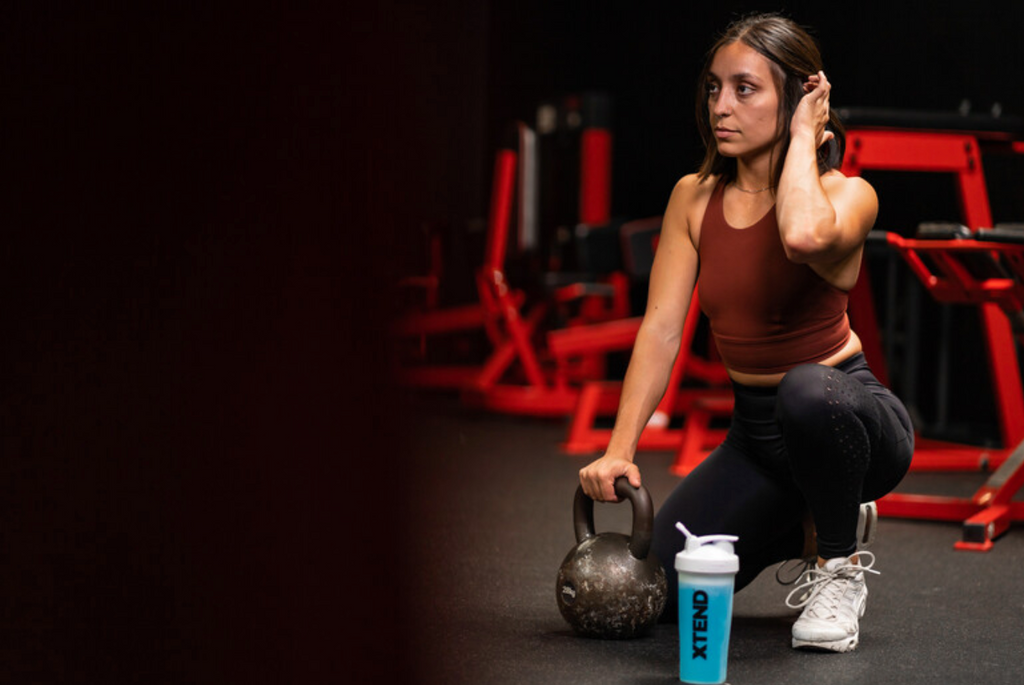

Whether it’s before a tough workout, on a hot day, or when you’re recovering after a long night out, there’s a good chance someone has told you about the importance of hydrating. Usually, people turn to electrolyte drink mixes to help them hydrate and replenish electrolytes. But finding the right electrolyte drink mix can be challenging for people that are looking to keep their sugar intake in check. We’re going to go over the benefits of hydration, why sugar is often paired with electrolytes, and examine the strengths and weaknesses of including sugar in your electrolyte drink mix.
The Basics & Benefits of Hydration
Water is a major component of our bodies, making up about 60% of our body composition.[1] Many of the biochemical reactions that take place in the body occur in water, making it an essential nutrient for the transport of nutrients, waste products and the maintenance of homeostasis. The European Food Safety Authority defines adequate intake of water as 2.0 L/day for women and 2.5L/day for men while the US Institute of Medicine defines adequate intake as 2.7L/day for women and 3.7L/day for men.[2]
There are discrepancies on a recommended water intake because of various factors that will impact this number like climate, activity rate, sweat rate, and diet. As an example, total sweat loss during sedentary work activity may amount to less than 0.2 L/24h while the total sweat loss during a 164-km cycle can exceed 9L during a 9-h ride.[3]

While there isn’t a consensus on the exact amount of how much water to consume in a day, the benefits of water are clear.
- Regulates body temperature
- Keeps joints & organs functioning
- Delivers nutrients to your cells
- Supports mental alertness & cognition
And when we lose fluids our performance suffers, as little as a 2% loss in bodyweight of water has reduced athlete's performances during lab tests.[4]
What are Electrolytes?
Electrolytes are minerals in our body that conduct electrical charges. Electrolytes play a role in regulating fluid balance, muscle contraction, and nerve impulse transmission. Sodium, calcium, potassium, magnesium, chloride, and phosphate are all electrolytes. We lose electrolytes when we sweat. Sodium and chloride make up a large amount of the electrolytes lost during exercise or heat exposure, while potassium only makes up a small amount.[5]
Sweat electrolyte losses depend on total sweat losses and the electrolyte concentration of sweat. In general, the more we sweat the more electrolytes we use. Our sweat rate will vary on factors like genetics, diet, heat acclimatization, type of exercise, exercise intensity, and exercise duration. In general sweat electrolyte concentration averages out to 805 mg sodium, 1062 mg chloride, 195 mg potassium, 20 mg calcium, and 9.72 mg magnesium all per L. [6]
The ACSM recommends athletes drink isotonic drinks (0.6-0.7 g of sodium per L) for activities shorter than 3 hours. And they recommend a more concentrated drink (0.7-1 g of sodium per L) for physical activity that lasts longer than an hour.[7]

How Do We Hydrate?
Our digestive tract consists of our mouth, esophagus, stomach, small intestine, large intestine and rectum. About 304 oz of water travels through ou gastrointestinal tract each day, and the small intestine absorbs up to 90% of this, with the remaining amount being absorbed by the large intestine.[8] This water absorption is thought to occur through osmotic gradients and water channels in our cells.
During osmosis, water diffuses in response to a gradient established from the absorption of electrolytes. Sodium is actively absorbed by sodium channels, potassium can be absorbed or secreted depending on electrolyte concentrations, and chloride is exchanged for bicarbonate across this gradient.[9]
The absorption of water depends on the absorption of solutes, especially sodium. The sodium we absorb gets pumped through cells creating an osmotic gradient, and water diffuses into s in response to this gradient. Both sodium and water can diffuse into capillary blood from within the small intestine.[10]

Another important concept to remember when discussing hydration is water balance. Our bodies work to maintain a state of homeostasis (keeping things in balance) and there are several mechanisms in place when things get out of whack. If we lose too many fluids (or consume too many), our body has sensors in place to promote a state of water balance. An example of this is the hormone arginine vasopressin (AVP) which gets released in response to hypertonicity. AVP acts on the kidneys to decrease urine volume and promote water retention. When plasma osmolality is decreased, AVP release is inhibited, and our kidneys can increase their urinary output again.[11]
Our kidneys play a major role in maintaining this water balance, they can conserve water by producing urine that is more concentrated than our plasma or they can rid the body of excess water by producing urine that is more dilute than our plasma.[12] So, in addition to hydrating by consuming water, we also maintain a water balance by regulating how much fluid gets excreted.

Is Sugar Good or Bad for Rehydration?
So, what’s the deal with sugar and electrolyte drinks? Why is it in so many drinks?
This can initially be traced back to the scientific discovery of enhanced sodium absorption in the small intestines of mammals when glucose is present, this observation led to the development of an Oral Rehydration Solution (ORS) that is on the WHO list of essential medicines.[13] Since then, most commercially available ORSs contain specific concentrations of sodium, potassium, and glucose for the purpose of promoting fluid absorption in the gut.[14]
Over the years, research on carbohydrate ingestion during exercise shows it had a beneficial effect on capacity and performance.[15] This made the inclusion of carbohydrates paired with electrolytes in sports drinks a logical fit. Especially for athletes that exercise intensely for several hours. The ACSM’s position stand regarding exercise and fluid replacement recommended the consumption of 30-60 grams of carbohydrate per hour for exercise lasting longer than an hour. Interestingly, the ACSM states that there is little evidence of any physiological or performance benefits between drinking a carbohydrate-electrolyte drink or plain water for exercise lasting less than an hour.[16]
In other words, carbohydrates can be beneficial during intense or longer duration exercise but not necessary for exercise of lower durations. So, while sugar can be good for hydration, especially during more extreme conditions outlined by the WHO or longer duration workouts as recommended by the ACSM, during most other situations people can hydrate fine without it. Generally, the electrolyte concentration found in sports drinks also happens to be much lower than the average amount of electrolytes we lose through sweat.[17] This can be an issue because while we do utilize carbohydrates during intense exercise, it’s the loss of electrolytes that most impacts body water deficits.[18]

Do Amino Acids Support Hydration?
Just like how our small intestine can effectively absorb electrolytes when bound to carbohydrates, our small intestines also have transporters for amino acids and peptides. The absorption of water and other nutrients is dependent on osmotic gradients impacted by sodium transport. This usually occurs through three mechanisms 1) neutral sodium chloride absorption 2) sodium absorption coupled to the absorption of organic solutes (like glucose aka sugar or amino acids) 3) electrogenic sodium absorption.[19] Some amino acids when co-transported with sodium appear to increase electrolyte and water absorption.[20] These amino acids and peptides that are co-transported with sodium in the intestine use carriers that are different than the glucose-galactose (aka sugar) carriers.[21]

How to Stay Hydrated, without the Sugar
XTEND® Healthy Hydration: Designed for optimal performance, Healthy Hydration is formulated with 6 key electrolytes, amino acids, clinically studied BetaPower, and Vitamin D + B-vitamins. We ditched the sugar for our hydration mix and instead used amino acids to help with the co-transport of electrolytes. We also include BetaPower betaine, a superfood extract ingredient that supports cellular hydration.

References
[1] https://www.ncbi.nlm.nih.gov/pmc/articles/PMC4529263/
[2] https://www.ncbi.nlm.nih.gov/pmc/articles/PMC7231288/
[3] https://www.ncbi.nlm.nih.gov/pmc/articles/PMC6315424/
[4] https://www.ncbi.nlm.nih.gov/pmc/articles/PMC2838466/
[6] https://pubmed.ncbi.nlm.nih.gov/17277604/
[7] https://www.ncbi.nlm.nih.gov/pmc/articles/PMC6213308/
[8] https://www.ncbi.nlm.nih.gov/books/NBK532263/
[9] https://www.ncbi.nlm.nih.gov/books/NBK507857/
[10] http://www.vivo.colostate.edu/hbooks/pathphys/digestion/smallgut/absorb_water.html
[11] https://www.ncbi.nlm.nih.gov/pmc/articles/PMC2908954/
[12] https://mcb.berkeley.edu/courses/mcb135e/kidneyfluid.html
[13] https://www.ncbi.nlm.nih.gov/pmc/articles/PMC3950600/
[14] https://www.ncbi.nlm.nih.gov/books/NBK562935/
[15] https://www.ncbi.nlm.nih.gov/pmc/articles/PMC4008807/
[18] https://jissn.biomedcentral.com/articles/10.1186/1550-2783-11-24
[19] https://www.ncbi.nlm.nih.gov/pmc/articles/PMC3043760/
[20] https://www.ncbi.nlm.nih.gov/pmc/articles/PMC8465972/
[21] https://journals.physiology.org/doi/full/10.1152/japplphysiol.00761.2004






